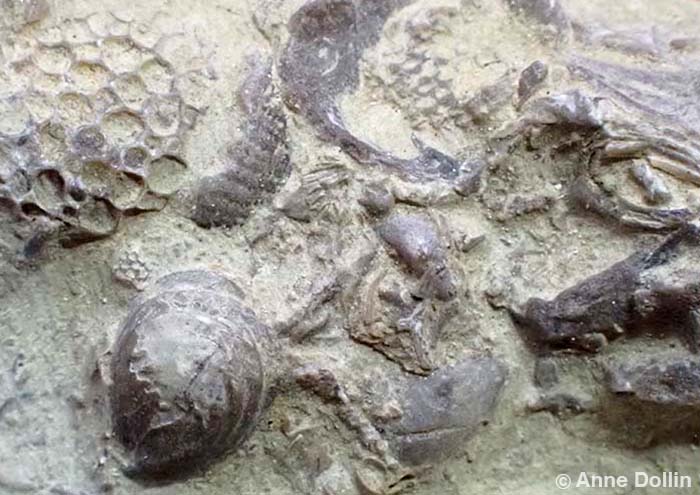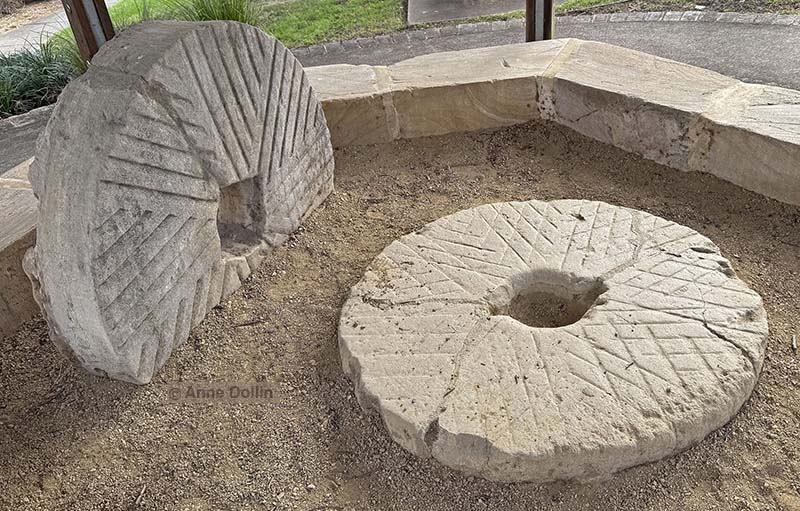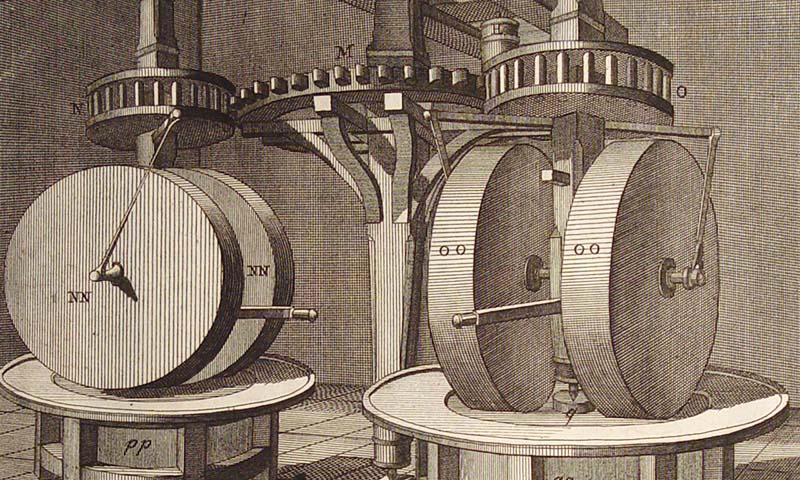
Millstone Types: Limestone
A softer sedimentary rock
Singleton Mills homepage > Overview of Stone types used for Millstones > Limestone Millstones
Milling with limestone
Limestone is a quite soft, sedimentary rock made of Calcium Carbonate. This material mainly came from corals and shells in the sea, and it may contain numerous fossils. The impressive White Cliffs of Dover in England are made of chalk, a form of limestone.

Above, detail of the very fine-grained grey limestone rock, with abundant fossils of shells and coral, in this fossiliferous limestone from West Midlands, UK. The full width of this image shows a 20mm-wide section of the stone. Macro image by Anne Dollin.
In England, some small primitive grain mills called 'querns', made from shelly or oolitic limestone,A have been found by archaeologists in Leicestershire and Lincolnshire;[1] and numerous limestone querns of different kinds have been found in France.[2]
A: Oolitic limestone. This type of limestone is made of a mass of tiny (less than 2 mm wide) rounded grains. Each grain has concentric layers of calcium carbonate. See photographs below.

Above, detail of the tiny, rounded, calcium carbonate grains that make up this oolitic limestone from Gloucestershire, UK. The full width of the main image shows a 20mm-wide section of the stone. The inset is a 6x more magnified view of the area within the red rectangle. Macro and microscope images by Anne Dollin.

Above, a location near Gislövshammar in Sweden, where millstones were once cut from limestone rock. Photograph by Jorchr. Wikimedia Commons.
Pure limestone lacks the gritty quartz grains found in other common millstone types such as Millstone Grit. So, it may not appear to be a good grinding material. However, a useful abrasiveness for milling can be provided by tiny cavities in the limestone left behind after fossils in it had dissolved away, or by minute arrays of cracks in the stone.[2]
Nevertheless, by the 1800s, limestone was not generally used for full-sized millstones in the UK as it was considered to be too soft. Instead British millers used much harder stone types such as: French Burr Stones, Cullin Stones, Millstone Grit or other high-silica sandstones and conglomerates.
Other specialised examples of limestone millstones
1. The Calcarenite Limestone Millstones of Norfolk Island
Calcarenite, a type of limestone, was successfully used to make full-sized millstones in an isolated British colony on Norfolk Island in the South Pacific in the late 1700s and early 1800s. Some Calcarenite Limestone millstones were imported from Norfolk Island into Australia for their early flour mills.
Read about the extremely rare Calcarenite Limestone Millstones  |
2. Limestone grindstones used to manufacture gun powder
Limestone was also sometimes used to make heavy grinding stones that rotated on their edges to mill gunpowder. If a limestone millstone did not contain any silica impurities, it was much less likely to cause a spark, and was therefore safer for milling gunpowder, than a millstone made from a silica-rich stone.[3]

Above, an engraving showing how millstones, mounted vertically, were used to grind gunpowder in an 18th Century mill. Image by Bigjoe5216, from Encyclopédie, published by Denis Diderot in 1751-1772. Wikimedia Commons.
REFERENCES
1. Ingle, Caroline Jane (1989) Characterisation and distribution of beehive querns in eastern England. PhD Thesis. University of Southampton, pages 68-69.
2. Fronteau, Gilles et al. (2020) Limestone millstones: facies, provenance and use of sandy to pure limestones in France. Journal of Lithic Studies, 7(3): 1-20.
3. Tucker, D Gordon (1987) Millstone making in England. Industrial Archaeology Review, IX (2): 167-188, page 171.
Read More About Millstones
•• Overview •• French Burr Stones •• Basalt-like Cullin Stones •• Millstone Grit •• Old Red Sandstone, Puddingstone, and Lodswoth Stone •• Granite •• Norfolk Island Millstones •• Artificial Millstones •• Colonial Millstones ••